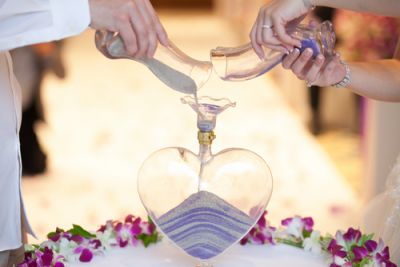 Unity ceremonies are common components of modern weddings, symbolizing the union that each couple creates. If you wish to imbue your nuptials with an extra dimension of significance, a unity ceremony may be the perfect way to accomplish this. While many couples choose to light a candle together, that’s not the only form these ceremonies take. Learn about your options so you can craft a version that fits your wedding and holds special meaning for you and your future spouse.
Unity ceremonies are common components of modern weddings, symbolizing the union that each couple creates. If you wish to imbue your nuptials with an extra dimension of significance, a unity ceremony may be the perfect way to accomplish this. While many couples choose to light a candle together, that’s not the only form these ceremonies take. Learn about your options so you can craft a version that fits your wedding and holds special meaning for you and your future spouse.
The Basics of Unity Candle Ceremonies
A unity candle ritual features two spouses jointly lighting a single pillar candle, each using a taper to kindle its flame. Wedding Wire’s Samantha Iacia discusses this ceremony, tracing its roots back about 40 years. Typically, one parent from each family lights a taper and places it on the table with the unity candle itself. The Knot remarks that each spouse’s mother usually ignites the tapers, but either parent can perform this function. In addition to representing the couple starting a joint life together, this custom also signifies unity between their families.
Unity Sand Rituals: Creating Beauty Together
While the usage of unity candles is widespread, unity sand rituals are also gaining popularity among engaged couples. Brides writer Kristi Kellogg describes the sand ceremony in which each spouse pours colored sand from a separate vase, blending the colors together to create a stunning display. The Spruce’s Nina Callaway reveals that it’s based on the original unity candle rituals, representing the harmony and accord between each half of the couple as well as their families. In fact, some couples ask their parents and other family members to participate in their sand ceremonies by adding different layers of colored sand.
Besides exuding aesthetic beauty, the resulting vase offers a lasting memento that can be displayed in the spouses’ new home. Sand ceremonies are also great options in outdoor spaces or venues that prohibit open flames. As with unity candle rites, you can find the supplies at most craft stores or specialty wedding retailers. Remember that you’ll probably also need a separate table, as many faiths have liturgical guidelines prohibiting the use of altars in their houses of worship for unity rituals.
Alternative Ceremony Ideas
The Knot’s Andrea Fowler and Wedding Wire’s Caitlin Krebs mention several kinds of unity rituals used in weddings today. Some couples plant a sapling or shrub together, representing marriage as a bond that needs tending and growth in order to thrive. For added significance, you can mix soil from two different places before the planting takes place. Handfastings are also a top choice, as Brides writer Jaimie Mackey explains. As a common part of pagan weddings, handfasting features a couple holding hands and exchanging vows while their wrists are bound together with cords.
Both Fowler and Krebs discuss tons of other ideas including tea ceremonies, blending wines, basket exchanges, and foot washing. Additionally, Martha Stewart Weddings lists a wide range of unity rite examples from several different cultures.
When Should These Rituals Take Place?
Many couples enact their unity candle rites after they’ve exchanged vows. However, keep in mind that you can schedule your unity ritual to occur at any time during your wedding ceremony. You may opt to include it as a separate rite altogether or during the exchange of vows.
The Beginning of a Beautiful Partnership
A unity ceremony signifies the act of you and your partner joining your lives together. You’re probably familiar with the versions that use candles, but there are many more variations from which you can choose. Also, you can combine ceremonial elements to craft and celebrate in your own way. No matter what you decide, your ultimate focus should be incorporating a ritual that holds special significance for you and your spouse-to-be.
Add Your Comment